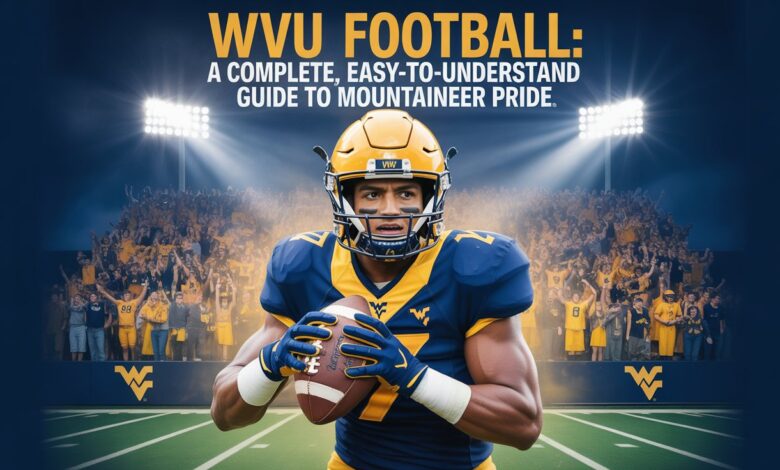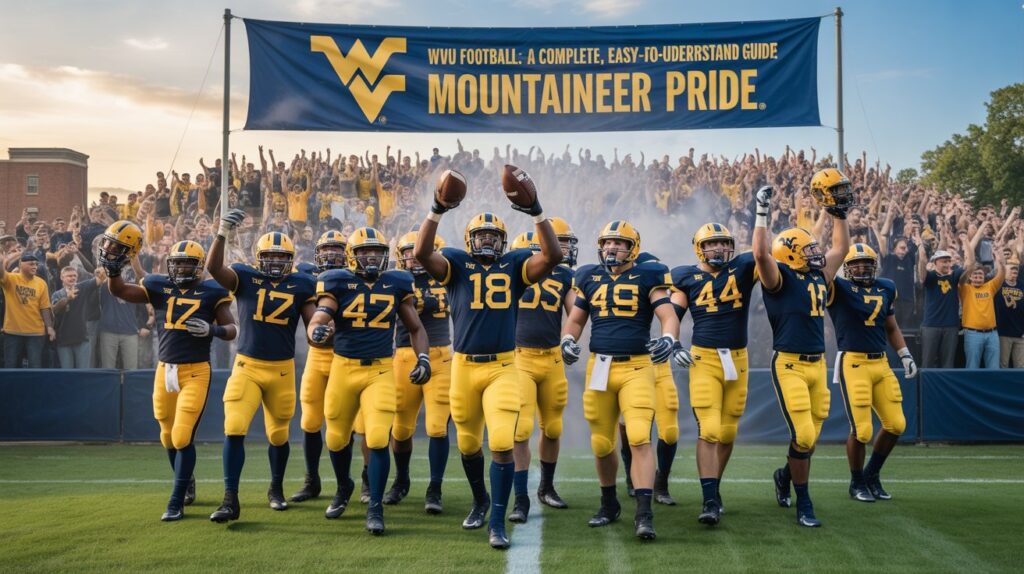WVU Football: A Complete, Easy-to-Understand Guide to Mountaineer Pride

Introduction
WVU football is more than just a sport—it’s a tradition, a lifestyle, and a source of statewide pride. Whether you’re a lifelong Mountaineers fan, a new student at West Virginia University, or just curious about college football, this guide will walk you through the program’s rich history and exciting future.
In West Virginia, Saturdays are about more than tailgates and touchdowns—they’re about community. From country roads to packed stadium seats, fans wear gold and blue with pride. WVU football runs deep in the hearts of its people.
This article covers everything you need to know about WVU football in a simple, fun, and friendly way. We’ll talk about the team’s past, present, famous players, game days, and more. Ready to gear up and shout “Let’s Go, Mountaineers”? Let’s start!
A History of WVU Football: Where It All Began
The WVU football story started way back in 1891. That’s over 130 years of tradition! In those early days, the team played on small fields with local rivalries. It was nothing like today’s high-energy, big-stadium games.
As time went on, WVU grew stronger. By the mid-1900s, the program started gaining national attention. It joined major conferences, earned bowl game invites, and built a dedicated fanbase that still stands strong today.
One thing that always stayed the same? Hard work, mountain pride, and loving the game. That’s the Mountaineer way. The history of WVU football is filled with big wins, tough seasons, and passionate fans who always believe in their team.
Milan Puskar Stadium: The Heart of Mountaineer Nation

When people think of WVU football, they often picture Milan Puskar Stadium, located right in Morgantown. This is where the Mountaineers play their home games, and it’s known for its wild and loud atmosphere. The stadium holds more than 60,000 fans!
Every game day, fans dress in blue and gold, pack the stands, and sing “Take Me Home, Country Roads.” The press box, high above the field, gives announcers and visitors a beautiful view of the Allegheny Mountains.
It’s not just a stadium—it’s where memories are made. From roaring student sections to touching military tributes, Milan Puskar Stadium is the heart of WVU football.
Conference Play: Competing in the Big 12
WVU football joined the Big 12 Conference in 2012. This move was a big change and gave the team even tougher competition. The Big 12 includes strong programs like Texas (formerly), Oklahoma, Baylor, Kansas State, and more.
Playing in the Big 12 means fast-paced games, lots of passing, and creative offenses. WVU had to adjust quickly, but the Mountaineers have held their own.
Every year, West Virginia plays 9 conference games against big-time teams. These matchups are tough, exciting, and often come down to the wire. Competing in the Big 12 helps WVU grow, recruit better, and stay on the national radar.
Rivalries That Fire Up the Fans
In college football, rivalries are everything. For WVU football, rivalries make game day even more exciting. One of the biggest and most talked-about matchups is:
WVU vs. Pitt: The Backyard Brawl
This famous rivalry started way back in 1895. It’s called the Backyard Brawl because the schools are only 75 miles apart. When West Virginia plays Pittsburgh, fans get loud, emotions run high, and every play feels like a championship moment.
Though the rivalry paused for a few years, it made a comeback in 2022—and it’s just as fierce as ever.
Other notable games include battles with:
- Virginia Tech
- Penn State
- Maryland
These rivalries are part of what makes WVU football so special. It’s all about pride, tradition, and winning for the state.
Legendary Players That Shaped WVU Football
Over the years, many amazing players have worn the blue and gold. Some were fast, others strong, and a few were just unforgettable. Here are a few legends in WVU football history:
- Pat White – A dual-threat quarterback who led the team to several bowl wins
- Steve Slaton – A dynamic running back with blazing speed
- Geno Smith – A record-breaking quarterback now playing in the NFL
- Major Harris – A QB from the late 80s known for his highlight-reel style
- Sam Huff – A Hall of Fame linebacker from the 1950s
These players made WVU a national name. Some went pro, while others remained local legends. But all of them helped write the story of WVU football.
The Spirit Squad, Marching Band, and Mountaineer Mascot
Game day in Morgantown isn’t complete without the cheer squads, the Pride of West Virginia Marching Band, and, of course, the iconic Mountaineer mascot.
The mascot wears a fringe buckskin outfit, carries a musket (used to fire after big plays), and shows up at every game to rally the fans. He’s not just a symbol—he’s a walking piece of Mountaineer pride.
Meanwhile, the band performs energetic halftime shows, pumps up the crowd pre-game, and even travels to away games. Add in the cheerleaders and dance teams, and you’ve got a full-on show.
All of them work to bring the energy and entertainment that make WVU football game days truly unforgettable.
Recruits and Rising Stars
Behind every great season is a group of fresh talent. WVU football works hard to bring in the best high school players from West Virginia and around the country.
Through social media, scouting, and campus visits, WVU recruits hard-working athletes who fit the Mountaineer spirit. Coaches look for speed, toughness, and a team-first attitude.
Every season brings new names, and fans love seeing these young players grow into game-changers. Some get early playing time; others wait for their chance. But all of them have the chance to become the next Mountaineer legend.
If you’re a recruit thinking about WVU, the message is simple: You’ll be part of something special. That’s the power of WVU football.
Coaching the Mountaineers: Leadership Then and Now
Coaches are the backbone of every great team. Over the many years of WVU football, leaders have come and gone, but each one left their mark.
Famous Past Coaches:
- Don Nehlen – Led the team from 1980 to 2000, becoming one of the winningest coaches in school history
- Rich Rodriguez – Known for high-speed offenses in the early 2000s
- Bill Stewart – Guided the Mountaineers to a huge win in the 2008 Fiesta Bowl
Today, the team is coached by Neal Brown, who came from Troy University. He’s focused on building up the program, developing players, and restoring WVU to national relevance.
Coaches are more than play-callers—they’re mentors who shape the future of WVU football.
Game Day Traditions You Have to See
If you’ve never been to a WVU game, there are a few traditions you need to know. These are things that every fan looks forward to:
- The Mountaineer Takes the Field – Before kickoff, the mascot fires his musket high in the air. Everyone cheers.
- Singing “Country Roads” – Win or lose, fans gather post-game to sing this West Virginia classic.
- Gold Rush and Stripe the Stadium – Special-themed dress codes where fans create amazing visuals in the stands.
- The Mantrip – Players walk through the crowd before games, touching a special piece of coal to honor local workers.
These unique traditions show what makes WVU football much more than just a game.
Bowl Games and Big Moments
WVU football has played in over three dozen bowl games since the program began. Some have been historic, while others helped close strong seasons with celebration.
One of the biggest was the 2008 Fiesta Bowl, where WVU upset Oklahoma in a thrilling, emotional game. That win proved that WVU could shine on the biggest stage.
Competing in bowl games means more national fans get to see WVU play—and the players get rewarded for all their hard work. For fans, bowl season is just one more reason to show off their Mountaineer spirit.
How to Follow WVU Football All Season Long
Can’t make it to Morgantown? No problem. There are plenty of ways to keep up with the WVU football season from anywhere.
- Watch on TV – Mountaineer games air on ESPN, FOX, CBS, or streaming apps like ESPN+
- Listen to Radio Broadcasts – The Mountaineer Sports Network brings the game to your ears
- Follow on Social Media – Twitter, Instagram, and YouTube share behind-the-scenes content
- Check Official Website – Schedules, tickets, rosters, and news are all there
No matter where you live, you can stay close to the team all season long.
FAQs
1. When did WVU football begin?
WVU’s first season was in 1891. The team has been competing for over 130 years.
2. What stadium does WVU football play in?
Home games are played at Milan Puskar Stadium in Morgantown, West Virginia.
3. What is the biggest WVU football rivalry?
WVU’s biggest rivalry is with the Pitt Panthers—known as the Backyard Brawl.
4. Who is a famous WVU football player?
Pat White, a former quarterback, is known as one of the best players in school history.
5. What conference does WVU football compete in?
WVU is a member of the Big 12 Conference and has been since 2012.
6. How can I watch WVU football games?
Games are broadcast on ESPN, FOX, CBS, ABC, or streamed online during the season.
Conclusion
At its core, WVU football stands for pride, heart, and the true spirit of West Virginia. It brings people together—families, students, alumni, and fans from all walks of life. Each game tells a story of grit, glory, and tradition.
From the sounds of “Country Roads” to the thrill of victory on a Saturday night, the Mountaineers continue to inspire. The program honors the past, excites with the present, and keeps aiming higher for the future.
So whether you’re watching from a stadium seat or your living room, one thing’s for sure—WVU football is something special you’ll never forget.





